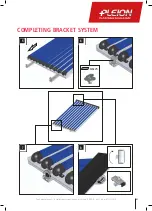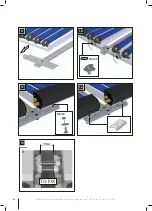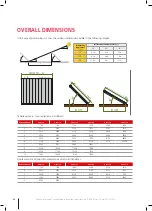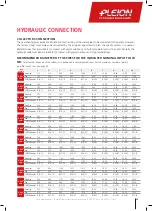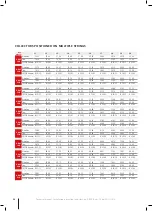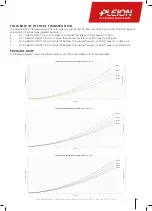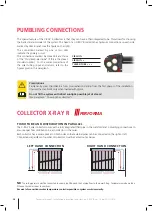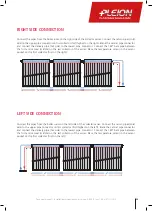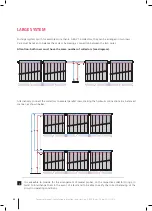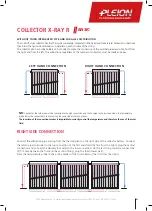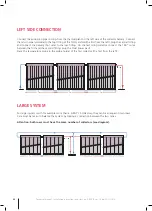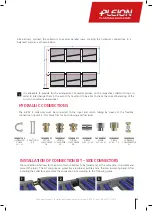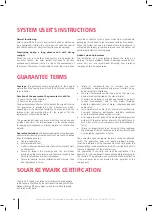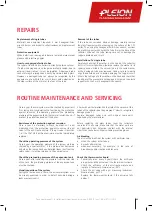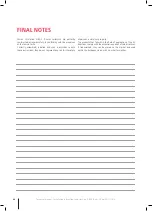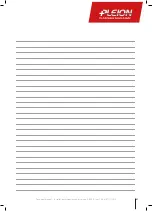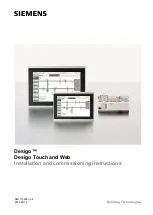
45
Technical manual – Installation instructions and start-up X-RAY R - ver. 1.0 del 07/11/2018
Replacement of single tubes
Materials and equipment required: 5 mm hexagonal Allen
wrench, bucket and broom to collect residues, and replacement
tubes.
Protective equipment
When defective or damaged tubes are replaced, always wear
gloves and protective goggles.
How to recognise defective tubes
The tubes of the XRAY R collectors constantly contain a vacuum.
If a tube is damaged or is no longer hermetically sealed, due to
external circumstances, it must be replaced. A damaged tube
cannot always be recognised directly by visible broken glass.
However, a damaged tube can always be recognised by the
appearance of a whitish film, which forms with oxidation, on
the silver surface of the mirror at the foot of the tube.
Removal of the tubes
If the tube has sustained obvious damage, carefully remove
the glass fragments without damaging the surface of the CPC
mirror. Then, using the hexagonal 5 mm Allen wrench, unscrew
the plastic support which holds the tube firm at the base of the
collector. Slide out the tube, taking care not to damage the
copper absorbers and circuit.
Installation of a single tube
Carefully check that the washer, on the head of the collector,
is still in its correct position; otherwise replace the washer in its
correct position. Slide in the vacuum tube, in the same manner
as the damaged tube was removed, taking care to correctly
align the absorbers and to avoid damaging the copper circuit.
Slide in the tubing up to the washer on the head and check that
the edges of the washer are not damaged. Screw on the plastic
support with the 5 mm hexagonal Allen wrench.
Once a year, the solar system must be checked by a specialist
firm, taking into consideration the functioning, the protection
against corrosion, the operating pressure, the preloading
pressure of the expansion tank, the thermal insulation and, if
present, the protective anode of the boiler.
Resistance of the protection against corrosion
Once a year it is necessary to check, by means of a pH
measuring stick, the protection against corrosion (the pH
value) of the anti-freeze mixture. If the pH value is less than
7, all the FAST G28 antifreeze mixture must be immediately
replaced.
Check the operating pressure of the system
Once a year the operating pressure of the system must be
checked by a specialist firm; if the pressure has decreased
and when the reason has been detected (leaks, loss from the
safety valve), it must be returned to the nominal value.
Check the pre-loading pressure of the expansion tank
Once a year, after removing the pressure from the solar side
of the tank, the pre-loading pressure of the expansion tank
must be checked.
Visual inspection of the system
During the routine annual check, the entire solar system must
be visually examined in order to detect possible damage,
leaks or excessive dirt.
Check with particular attention the state of the vacuum of the
tubes of the collector (see the paragraph “How to recognised
damaged tubes”).
Replace damaged tubes only with original spare parts
supplied by the manufacturer.
Before replacing the glass tubes, cover the collectors
concerned. In any case, make sure that the metal parts are
not particularly hot. Attention: contact with the internal
circuits can cause burns. Wear suitable protective gloves.
Air
-
bleeding
The air must be bled from the system with particular care:
•
when the system is started up
•
4 weeks after start-up
•
whenever necessary; for example, in the case of
breakdown and/or routine maintenance.
Check the thermo-vector liquid
•
Periodically (max. every 2 years) check the antifreeze
properties and the pH value of the thermo-vector liquid.
•
Check the efficiency of the anti-freeze mixture and
replace it if necessary. Normal value: -20°C
•
Check the pH value with a pH measuring instrument.
Nominal value: pH 7.5
•
Replace the thermo-vector liquid if the pH value falls
below 7.
REPAIRS
ROUTINE MAINTENANCE AND SERVICING

